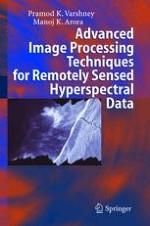2004 | OriginalPaper | Buchkapitel
Support Vector Machines for Classification of Multi- and Hyperspectral Data
verfasst von : Manoj K. Arora, Pakorn Watanachaturaporn
Erschienen in: Advanced Image Processing Techniques for Remotely Sensed Hyperspectral Data
Verlag: Springer Berlin Heidelberg
Enthalten in: Professional Book Archive
Aktivieren Sie unsere intelligente Suche, um passende Fachinhalte oder Patente zu finden.
Wählen Sie Textabschnitte aus um mit Künstlicher Intelligenz passenden Patente zu finden. powered by
Markieren Sie Textabschnitte, um KI-gestützt weitere passende Inhalte zu finden. powered by
As discussed in Chap. 5, support vector machines (SVMs) have originated from statistical learning theory for classification and regression problems. Unlike the popular neural network classifiers, SVMs do not minimize the empirical training error (Byun and Lee 2003). Instead, they aim to maximize the margin between two classes of interest by placing a linear separating hyperplane between them. While doing so, the upper bound on the generalization error is minimized. Thus, SVM based classifiers are expected to have more generalization capability than neural networks. Other advantages of SVMs are their ability to adapt their learning characteristic via a kernel function and to adequately classify data on a high-dimensional feature space with a limited number of training data sets thereby overcoming the Hughes Phenomenon. The theoretical background on SVMs has been presented in Chap. 5. This chapter builds on this theoretical knowledge to apply SVMs for classification of multi and hyperspectral remote sensing data.
